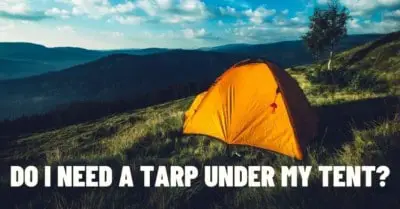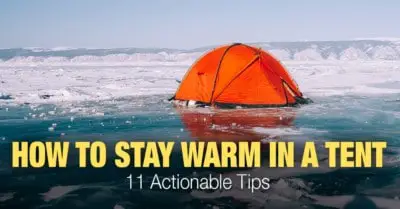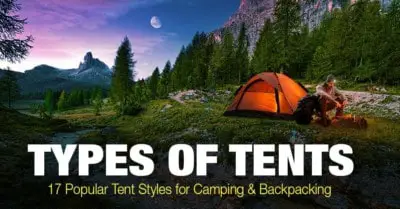Do you want to go camping this winter, but you’re struggling with how to insulate a tent? A sleeping bag alone won’t be enough to protect you from the frigid seasonal temperatures. How do you keep your tent nice and toasty for wintertime fun in nature?
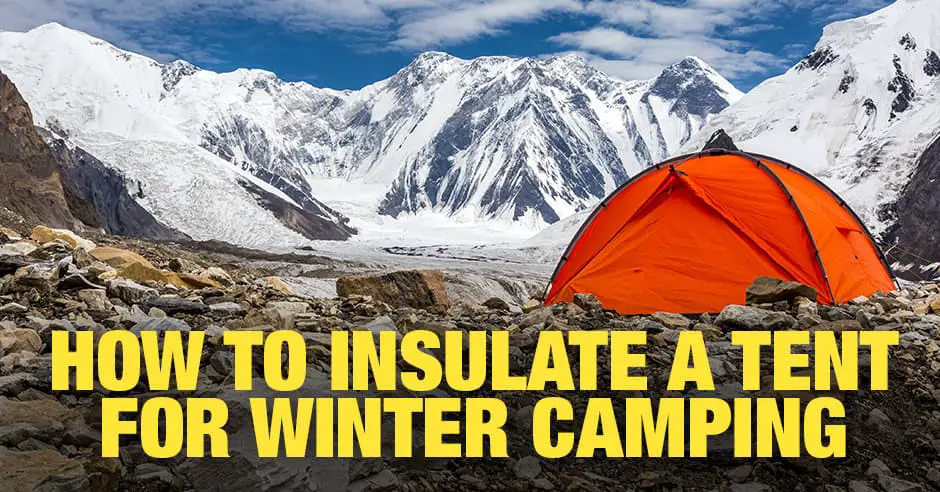
Here are some methods for insulating a tent for winter camping:
- Pick a location that’s already somewhat insulated
- Use a smaller, four-seasons tent
- Sleep in an insulated sleeping bag or sleep pad
- Strategically place water bottles or heat packs
- Wear thermal clothes and add layers
This guide will elaborate further on your many options for insulating a tent. We’ll also discuss whether there’s such a thing as the weather being too cold for camping (hint: there is) and if you can safely use a heater in your tent to stay warm. Keep reading!
The Importance of Body Heat When Camping in the Winter
Let’s start by talking a bit about insulation and how it works. When you insulate something, you’re preventing heat transfer from occurring quickly.
Heat transfers in one of three ways: radiation, convection, or conduction. This might get a little technical, but it’s good info to have, so let’s explain the differences between radiation, convection, and conduction heat transfer.
Heat conduction is how heat moves when two items of varying temperatures make contact. Convection heating works sort of the same way, but heat transfer occurs when fluid moves, including plasma, gas, or liquid. Heat radiation is when particulate matter moves thermally to generate electromagnetic radiation.
Why are we telling you all this? Remember, by lessening conduction and radiant heat, you get insulation. One of the most reliable means of insulating your tent is to use the heat you already have. You know, your body heat.
in a 2016 report, Stanford University states that our body heat is 6.27 by 106 joules daily if we eat 1,500 calories a day. It’s believed that we can produce between 100 and 120 watts of energy when we’re at rest. In other words, it’s enough energy that we could power a car and keep it going for up to 15 minutes.
Harnessing the power of your body heat and using it to warm up and keep warm in a small space like a tent will come in handy!
How to Insulate a Tent for Winter Camping
Your body heat can be a great insulator, but you might want to augment that natural heat with the following.
1. Choose a Location with Natural Insulation
Just like we ourselves provide insulation, so does the nature that’s all around us. You just have to know where to look.
For example, shrubs are a natural insulator since they safeguard your tent from the wind. If you can camp within the opening of a cave or even inside the cave (safely, of course), that’s another insulating location. So too is camping deep in the woods when you’re surrounded by trees, as the trees act sort of like a windbreaker.
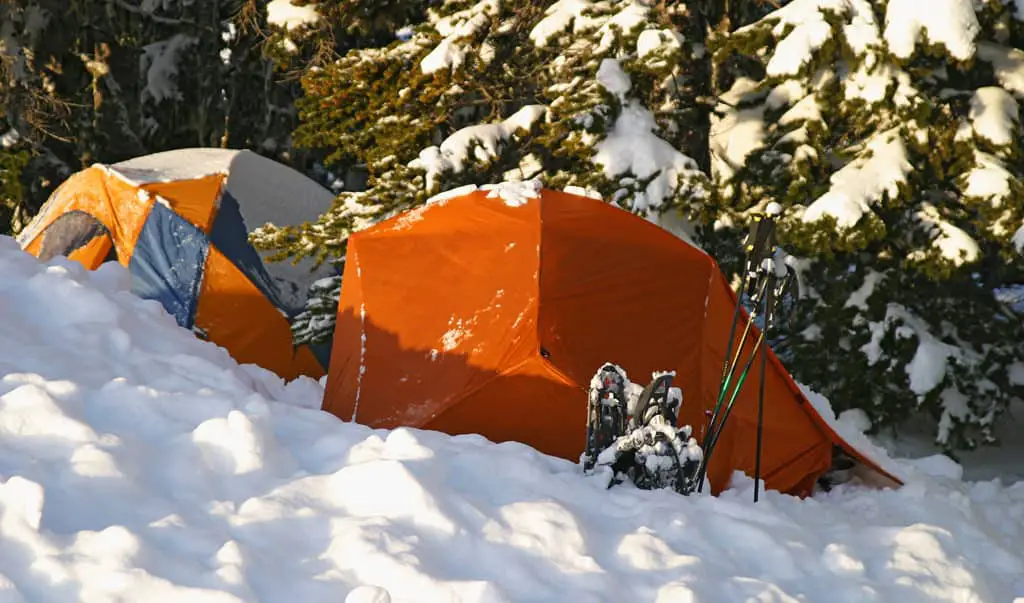
Mountainsides and open areas like unenclosed fields will let the wind blow unobstructed. Whatever insulation you achieve will quickly be undone over and over again.
What if you can only camp in open areas? Try a DIY windbreaker out of snow, which we’re sure is already on the ground if you’re camping in the winter. Stack up the snow into a wall-like structure that’s thick and several inches tall. The snow will stop the wind from reaching your tent as readily.
2. Try a Four-Seasons Tent
For the winter camper, a four-seasons tent is highly recommended. Unlike three-season tents, which are only intended for use from spring through autumn, four-season tents are built for the rigors of being outdoors in the winter.
You won’t see any mesh panels in a four-seasons tent, only nylon or polyester for drawing in more warmth. The tent should include vents that you can use to prevent condensation buildup. You also want a vestibule or rain fly in your tent that extends down the tent’s whole length. The vestibule may include flaps for you to stuff snow like a homemade windbreaker.
Aluminum framing and intricate framework throughout a four-seasons tent are like a skeleton under your tent’s fabric layers that can stand up to a few inches of snow without collapsing.

Four-season tents are heavier, weighing eight to 16 pounds or less. Although you could use them in the spring and summer, it’s not really advisable since they’re so thick. You’ll be sweating quickly.
3. Downsize Your Tent
Remember how we said the average human could produce 100+ watts of natural body heat when relaxing? That’s enough to generate power to a 1,600-lumen lightbulb, so it’s nothing to sneeze at.
That said, your own natural insulation might not suffice if you have an especially large tent. It’s much the same story when heating or cooling a big home. You need to buy a heater or air conditioner that generates enough power for a large space. You wouldn’t need nearly as much heating and cooling power for a studio apartment.

Downsizing isn’t easy, we know. Reducing the size of your tent means you can bring fewer people, and you typically have to be choosier about the amenities you take with you. For wintertime camping, though, we’d recommend it.
4. Insulate the Tent Floor, Then Everything Else
This time, we’ve talked about the wind as the main deterrent to insulating your tent, but that’s not the only source of cold you have to worry about. Underneath you, the wintry ground is bone-chillingly cold. Never do you realize this more than when you go to lie down to fall asleep. You feel like someone’s dunked you in an ice bath.
Will your sleeping bag insulate you? Yes, and more on this in a moment. However, we don’t recommend relying on only your sleeping bag for floor insulation. Instead, use a radiant barrier such as reflective foam, which you can pick up online or at any home improvement store. Buy double-sided foam, as you need the reflective foam to work on both sides to keep you warm as you sleep all night.
It’s better to have more reflective foam than less, as you should create a barrier that’s at least five inches up on both sides of the tent walls. The space between the walls and the tent footprint is where cold air is most likely to enter your tent.
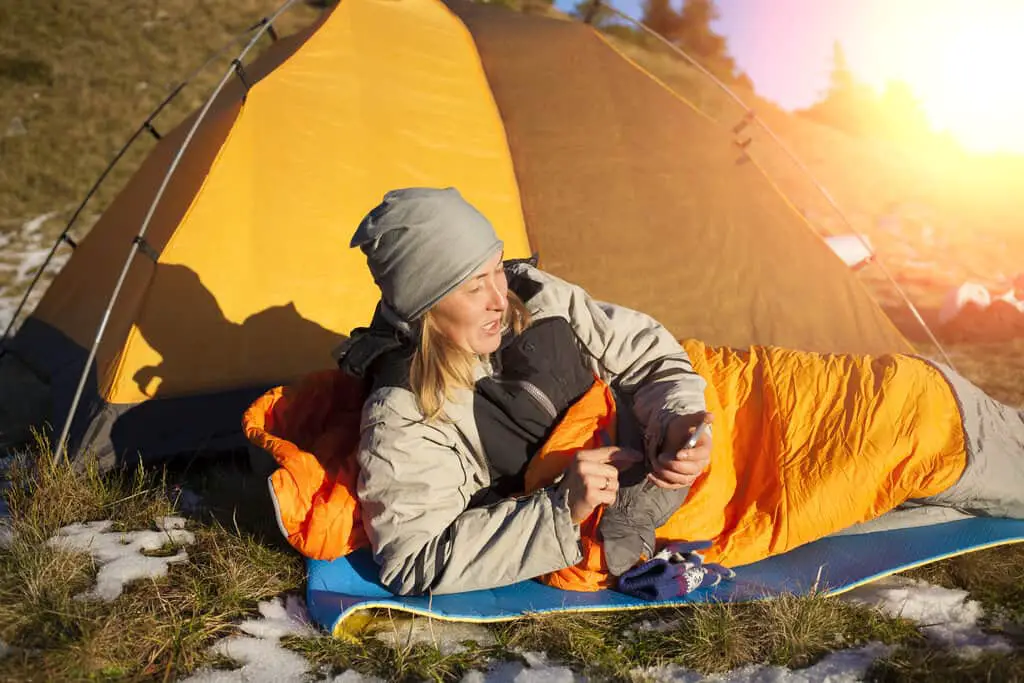
If you want an even more luxe option, try heated carpeting or floor mats. You will need a source of power to warm up the mat and keep it toasty, which may not be available everywhere you camp. If you can use heated carpeting, combine it with the reflective foam rather than choosing one over the other.
5. Use a Sleeping Bag with a Good Temperature Rating or an Insulated Sleep Pad
We said we’d get back to it, so let’s talk about your sleeping options when creating insulation in your tent.
As a seasoned camper, you likely already own a sleeping bag, but is it made for winter camping? Sleeping bags are given a temperature rating, so it’s time to start now if you have never paid attention to that before.
You may see one of two ratings on your sleeping bag, the comfort or lower limit rating. Comfort ratings are more frequent in women’s bags than men’s and indicate how comfortable you may be if you’re a naturally cold person when sleeping. A lower limit rating is regarded as more accurate since it represents the lowest temperature someone who sleeps warm might withstand. This rating is used for men’s sleeping bags.
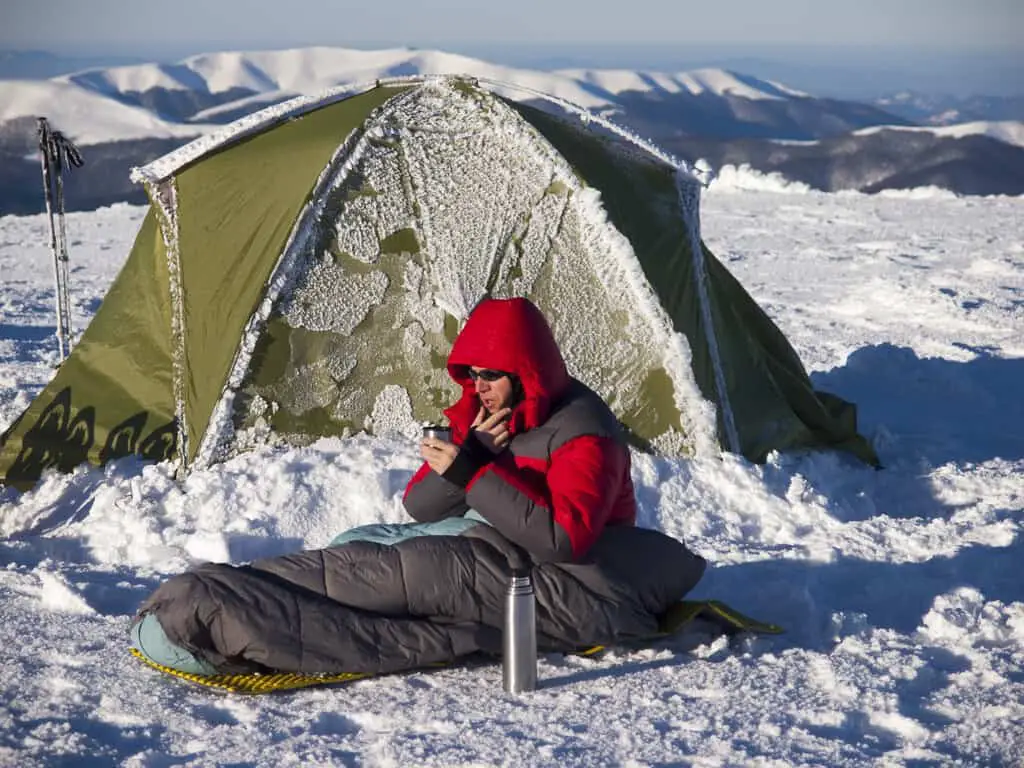
If your bag was tested in a laboratory, it will have an ISO or EN label, then the temperature. ISO stands for International Standards Organization and EU for European Norm. ISO tests sleeping bags for temperature ratings today and is considered the more current standard.
Make sure the bag is streamlined when shopping for a winter camping sleeping bag. The more room in your sleeping bag, the easier it is for the body heat to exit, limiting your warmth.
You can also try an insulated sleeping pad, which uses the R-value as an indication of warmth. R-value, which is a common insulation term, describes the pad’s heat flow resistance. Sleeping pads with an R-value of around 2 are not so good, those close to 5 are great, and 5.5 are best in winter.
6. Warm Yourself with Water Bottles or Heat Packs
Another useful insulation method to try is this: buy some heat packs. Some campers put a few heat packs in their pockets. You can also surround your sleeping bag with heat packs.
Heated water bottles work just as well as heat packs if that’s all you have available!
7. Wear Thermal Clothes and Layer up
How you dress is also incredibly important in keeping you warm during a winter camping excursion. You can wear thermal clothing from head to toe, including thermal underwear, long johns, socks, shirts, and the like.
Upgrade your whole camping wardrobe to thermal clothes if you wish, then layer. As you put on clothes on top of clothes, you pack in the warm air and keep it close to your body, which will insulate you.
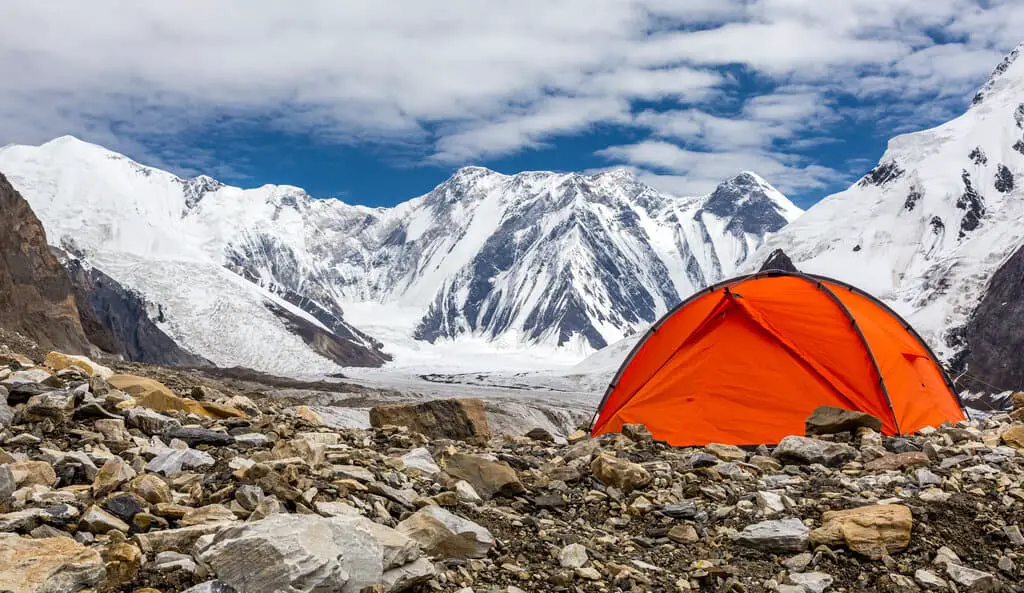
How to Insulate a Tent FAQs
Still, have more questions about insulating a tent for winter camping? Don’t worry, as we’ve got the answers!
What Type of Heater Can You Use in a Tent?
Let’s say you’d rather use a good, old-fashioned heater for warming your tent. Which types of heaters are best for these purposes?
A propane heater is one such option, especially if you know you’ll camp somewhere without power. Flameless, the biggest risk of using a propane heater is carbon dioxide.
Breathing in excess carbon dioxide can lead to confusion, fast breathing, unconsciousness, and even heart arrhythmias and respiratory failure. Make sure your tent has vents that you can pass the carbon dioxide through!
The second type of heater you can try in your tent is an electric one. As we’re sure we don’t have to tell you, electric heaters need to plug in, so you must get power at the campsite. At least there’s no carbon dioxide risk.
How Cold Is Too Cold to Camp?
Is there a certain temperature range where you should pack it in and wait until warmer days for camping? If you’re new to camping, around 30 degrees Fahrenheit might be too cold to deal with. Considering that some insulated sleep pads have an R-value rated for zero degrees with the right gear, any non-negative temps are okay!
Conclusion | How to Insulate a Tent
Camping in the winter brings with it its own unique set of challenges, especially when it comes to staying warm. You have many means of insulating yourself through heating pads, sleeping bags, your own body heat, or even Mother Nature. Be safe and stay warm out there!



